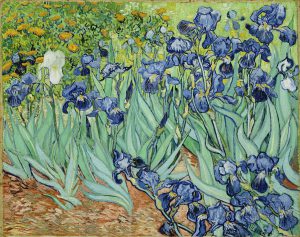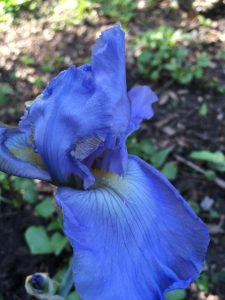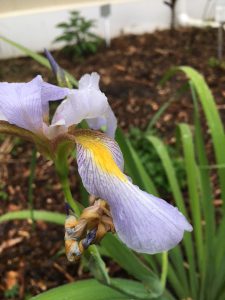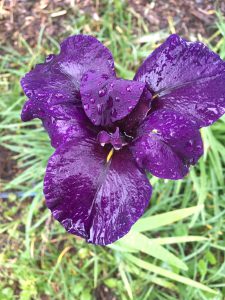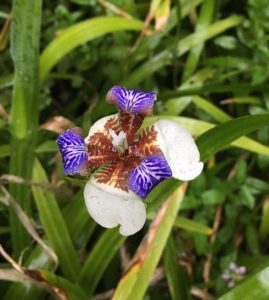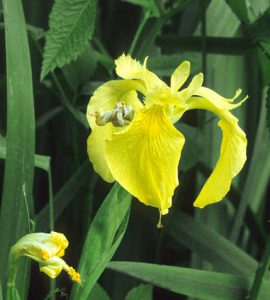Have you noticed all of the blooming irises? Their striking shapes and colors grab my attention each time. Irises are named for the Greek word for rainbow and are often called flags. Irises, both true Iris and those with iris in the common name, are not only easy on the eyes, but also easy to grow in the Florida garden. North Florida gardeners have many varieties of iris to choose from, including those that prefer wet sites, drought-tolerant species, intricate hybrids, and native species.
All irises are in the plant family Iridaceae and have six flower petals; a lower set, called the sepals, or falls, and an upper set, known as standards, that are often upright. The base of the sepals, known as the signal, can have a variety of colors and patterns. Irises are clump forming plants with long, strap-shaped leaves. They need occasional dividing and propagate easy by rhizomes. Few pests bother them.
Here are a few common iris plants that grow well in our area.
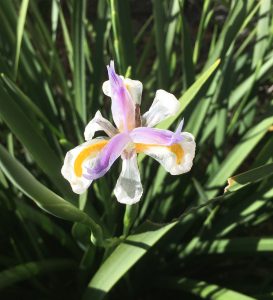
African Iris blooming on January 2nd, 2018 in the Leon County Extension Office Demonstration Garden. Credit: Mark Tancig, UF/IFAS Extension Leon County.
African Iris (Dietes vegeta)
This non-native plant is not actually a true Iris but is a tough and versatile plant. Its sepals are bright white with a yellow signal. The standards are purple. This plant can be grown in full sun or part shade, from standing water to droughty conditions. It works nicely as a border or foundation planting. Flowers only last a few days but are produced throughout the year. We had one blooming in our Demonstration Garden through a cold snap this past January. Cold weather can cause leaves to turn brown or gray, requiring some maintenance to improve appearance.
Bearded Iris (Iris x germanica)
A non-native, true Iris, bearded irises are the fancy hybrids that can come in many different colors. The “bearded” refers to the many hairs along the signal. Bearded irises prefer sunny locations and bloom in spring.
Blue Flag Iris (Iris versicolor and Iris virginica)
Two species of Iris go by the same common name, blue flag iris. These two are often misidentified in the nursery trade as well. Both have purple flowers that bloom in the spring, are native, and occur naturally in wetland areas. Gardener can have easy success with these in irrigated and/or rain gardens with some light shade. To tell the two apart requires a careful look at the lower sepals, or falls. Iris versicolor’s sepal has a greenish-yellow signal (base), surrounded by a white background with dark purple veins. The sepal of I. virginica has a bright yellow signal with little prominent veining. They also both have a 3-angled fruit.
Louisiana Iris (Iris spp.)
The name Louisiana iris refers to five true Iris species – I. brevicaulis, I. fulva, I. giganticaerulea, I. hexagona, and I. nelsonii – that are native in and around Louisiana. They easily hybridize with each other and these hybrids have become popular garden cultivars. Louisiana iris prefer moist soils and full sun.
Walking Iris (Neomarica spp.)
Another unofficial iris, most plants in the Neomarica genus share the same “walking” attribute. Small plantlets can develop at the top of the flower stalk and then fall over to start a new clump of plants. These do best in part shade to shade and have a long flowering period. They are somewhat cold tender so may die back but will return in the spring.
Yellow Flag Iris (Iris pseudoacorus)
This non-native Iris is one that you want to keep out of the garden. Yellow flag iris is known to invade natural wetlands and has been designated invasive by the UF/IFAS Assessment of Non-Native Plants. It’s easily distinguished from the other irises listed above by its bright yellow flowers. If you have this iris, remove fruit and carefully dig out the rhizomes, place in a trash bag, and dispose of it in your solid waste bin.
For questions regarding iris identification or care, contact your local UF/IFAS Extension Office.
- Tiny Invaders - February 15, 2024
- Bird Feeder Surprises - January 11, 2024
- Storm Cleanup an Opportunity for Practicing Florida Friendly Landscaping Principles - September 7, 2023

